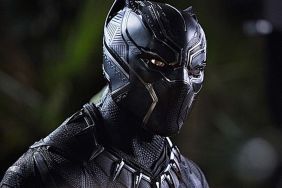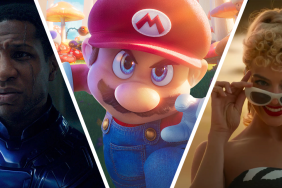Director Jordan Vogt-Roberts on his stylistic return of the King and on building a big screen Kong-tinuity
More than eight decades after the original Merian C. Cooper-produced King Kong gave birth to cinema’s “eighth wonder of the world,” Legendary Pictures and Warner Bros. Pictures are breathing new life into the gargantuan beast with this Friday’s Kong: Skull Island. Arriving from director Jordan Vogt-Roberts (best known for the 2013 coming-of-age drama The Kings of Summer), this new take introduces the mighty ape to the Godzilla cinematic universe launched with the 2014 Gareth Edwards film. While Skull Island is chronologically a prequel to Godzilla, the pair are already set for a big screen showdown in 2020.
CS had a chance to sit down with Jordan Vogt-Roberts to talk about his stylish approach to the Kong mythos. In the below interview, the filmmaker reveals some of the alternate routes that Skull Island could have taken on its way to the screen. He also shares his own “fan fiction” theory on how Skull Island connects to previous lore and explains why, despite a great deal of improvisation on set, you shouldn’t ever expect a significantly longer cut or any deleted scenes.
Kong: Skull Island stars Tom Hiddleston, Brie Larson, Samuel L. Jackson John Goodman, Jing Tian, Toby Kebbell, John Ortiz, Corey Hawkins, Jason Mitchell, Shea Whigham, Thomas Mann, Terry Notary and John C. Reilly. Directed by Jordan Vogt-Roberts, Kong: Skull Island is scripted by John Gatins and Max Borenstein. Catch it in regular and IMAX theaters March 10.
RELATED: Skull Island Photos: Explore the Work of Mason Weaver
CS: Congratulations! It seems that there has been a very positive response to the film so far.
Jordan Vogt-Roberts: It’s been so satisfying seeing people finally watch it. It’s not like a normal movie where you’re so cooped up all the time in the edit bay and people can’t see the movie. It’s doubly weird because you’re cooped up in the edit bay and people can’t see the movie and the effects aren’t done. It takes so long to be able to show people this thing. The response has been so great so far. For me, as a nerd, it’s so great seeing people who legitimately cherish monster movies and creature features. That Kaiju fans and people who love genre stuff appreciate it makes me really, really happy.

CS: In Gareth Edwards’ “Godzilla,” it was implied that the events of the 1954 original film might have happened in this new cinematic universe. Do you consider the 1933 “King Kong” story as having occurred in the timeline of “Kong: Skull Island”?
Jordan Vogt-Roberts: I have my own fan fiction of how this movie fits. The boat that they go to on the shrine on the island is called the Wanderer, which is the name of the Venture, the ship in the ’33 film, in the novelization. I have my own fan fiction about that film crew going to the island and a lot of those events taking place. That’s why I included a triceratops skull on the island. To say “dinosaurs were here and maybe not that long ago.” But here, we’re not dealing with dinosaurs. That’s the only film I would connect it to, although there’s trouble with that because A, you’d be saying they never made it off the island and B, in “Son of Kong,” the island sinks. But, to me, there’s no continuity with any of the other films.
CS: Because it’s set in 1975, though, it could sort of be thought that the events of the 1976 film follow.
Jordan Vogt-Roberts: (Laughs) Yeah, that’s a slightly different take on the character and all that. I would like to think that our Kong has a slightly different fate than eventually having a heart transplant in “Kong Lives.”
CS: I’ve heard that there was originally a script for “Skull Island” that was set in 1917.
Jordan Vogt-Roberts: When they first came to me about the movie, I said, “Awesome! I love King Kong. I love monsters. But why does this movie need to exist?” Audiences are smart. They don’t want to be just given the same thing. They gave me a script — a very, very cool script — by Max Bornstein — that took place in 1917. I just felt that 1917 wasn’t that different from 1933. The vibe of the script wasn’t something I necessarily wanted to make. Max is an amazing writer, but that version just wasn’t for me. So they said, “Well, what version do you want to make?” I said, “I don’t know if there is a version I want to make.” They said, “Go away for the weekend and think about it.” So I went away and thought about it for a long time. Suddenly, I don’t know where it came from, I got this idea. Part of it came from research. In the early ’70s, they launched satellites into the sky as part of the Landsat program. They were looking down at the Earth. Then the ’70s with the choppers and the smoke and the searing sunset with Kong silhouetted and Hendrix playing. That popped into my brain and I was like, “F—k. ‘Apocalypse Now’ and ‘King Kong’? I’ve never seen that. Vietnam war and monsters? I’ve never seen that.” Then I became really excited. That’s a movie I can make. That’s a really interesting access point. I pitched them that idea honestly thinking that they were going to laugh me out of the room and just be like, “We’re not going to make that movie. Are you crazy?” Instead, they were, “Cool! Let’s do it. Let’s make that version of the movie!” So I said, “Oh, s—t! Now how do we do this?” We kind of did a page one rewrite. Then we were really fortunate to be able to bring Max back down the road to be able to work on that script.

CS: There was also a point where J.K. Simmons was attached to play a role and he mentioned that the story was set in Detroit. Was that an alternate take you had in mind?
Jordan Vogt-Roberts: At one point, yes. That was this same version of the movie, but there was a version I had done where the opening took place in Detroit. The name is actually a holdover from that. It was a reference to the Packard car company. That version essentially was this version to some degree, but the setup and some of the characters were very different. I loved the idea of, if you were going to start a Kong movie, you’d naturally think, “New York!” I liked the idea of being, “No, this in Detroit.” I’m from Detroit. I love that place. There was a grit and a message to that that I was really interested in. That version essentially was this version with many, many tweaks.
CS: Is there a special challenge involved in making sure that “Skull Island” fits appropriately into the “Godzilla” cinematic universe?
Jordan Vogt-Roberts: I’m really fortunate because Legendary and Warner Bros. trusted me to say, “Audiences are smart and they’re sick of having this franchise s—t jammed down their throats. They’re sick of having ten minutes of exposition in one movie that’s just setting up another movie. They let me tell the best version of this movie. Let me subtly lay pipe — and overtly lay pipe — that connects it to what will come. But, most importantly, let me tell a story that makes you fall in love with Kong so that later, you say, “F—k yeah! I want to see that Kong fight Godzilla!” So there was a lot of groundwork being laid, but I was very fortunate that it didn’t get jammed into the movie. We didn’t have to divert our movie in order to do it. It’s a delicate balance. You need to make sure that it fits into the confines of everything being planned. But I think that a lot of these big franchise movies really do a disservice to the audience by being more concerned with what’s coming next rather than just tell a good story with a beginning, middle and end.
CS: There’s a true ensemble at play in “Skull Island” in that every character gets a moment or a line of their own. Is that something that primarily clicks on set or is that found in the editing room?
Jordan Vogt-Roberts: That’s both. There’s a character named Landsat Steve. He gets stomped on by Kong at the end. It’s a small role, but he’s played by Marc Evan Jackson, who is an actor that I’ve been working with for years. I called him up and said, “There’s this guy who’s basically an extra in the movie. I want you to come and travel around with us. We will work you into this movie just with improv and playing and everything.” There are huge chunks of this movie that are improvised. The John C. Reilly stuff on the boat with Thomas Mann. A bit chunk of that is improvised. Him in the loft is he and John Ortiz riffing. There’s a big part of it that is just finding movies. Working that into an ensemble is a lot of fun.

CS: I was reading that you also had Brie Larson’s camera able to take photos throughout production.
Jordan Vogt-Roberts: The props department asked, “Do you want the camera to be working? It’s way harder for us if it’s working.” I said, “I don’t care. I want the camera working and I want film in the camera at all times.” If she’s taking a photo, she’s actually taking a photo. I told Brie about that idea and she really ran with it. She’s a photographer and a director herself.
CS: Does that mean that we’ll be seeing any extended or deleted scenes down the road?
Jordan Vogt-Roberts: I hope not! I would do a cut that is probably five extra minutes. Most of it would probably honestly be a nature montage. Stuff that is not the most commercial. But I’m not a big fan of deleted scenes and stuff like that because when I watch stuff like that, it confuses me as to what the canon is. Am I supposed to think a deleted scene is canon or not? If it’s not, I kind of wig out seeing it. I don’t like deleted scenes.
CS: Do you think you’ll return to this cinematic universe?
Jordan Vogt-Roberts: I don’t know. I want to go do some other stuff for a bit. I keep joking that the movie I’d be most interested in doing in this universe is a prequel about young John C. Reilly on the island. Him and Gunpei with a katana fighting monsters. What’s their relationship with the villagers like? I would make the s—t out of that movie. But other than that, we’ll see.
(Photo Credit: Chuck Zlotnick)









